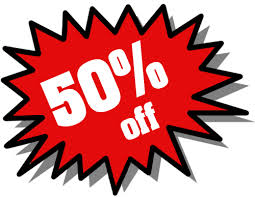 “Sometimes, We Want Prices to Fool Us” is the title of today’s New York Times article that notes that “…most shoppers, coupon collectors or not, want the thrill of getting a great deal, even if it’s an illusion.”
“Sometimes, We Want Prices to Fool Us” is the title of today’s New York Times article that notes that “…most shoppers, coupon collectors or not, want the thrill of getting a great deal, even if it’s an illusion.”
You want proof? The article reports that J.C. Penney suffered a whopping 25 percent drop in sales over the last year due to its decision to stop promoting sales and offering coupons and instead focus entirely on offering “everyday” low prices.
That the J.C. Penney Board of Directors ousted its CEO over these results is understandable.
Yet, don’t you sympathize with what the strategy was trying to accomplish? The article explains that the “everyday low prices” strategy provides great efficiency and predictability in a company’s supply chain – while eliminating the substantial labor of managing a wildly unpredictable process. Who doesn’t appreciate the desire to economize operations by stabilizing supply and demand.
We in the arts & cultural sector should pay special attention to the failed J.C. Penney strategy because it looks TOO MUCH like the way the vast majority of performing arts organizations price & sell their tickets.
If your organization is about to publish its 2013-14 season brochure, then you are GUILTY AS CHARGED. Consider what you’re doing in the context of the J.C. Penney experience – you’re locking yourself into a set ticket price (even with discount benefits for “series tickets” or “members”) – FOR THE ENTIRE NEXT YEAR.
A step in the right direction is the growing popularity of “dynamic ticket pricing” – where you publish your fancy season brochure WITHOUT listing ticket prices. Use the web – or perhaps an inexpensive ticket price supplement – to explain that ticket prices may adjust – and then reserve the right to re-set your prices every week, month, quarter or whenever you feel like it.
I have to admit, though, that upon reading of the J.C. Penney experience, I’m increasingly concerned that while “dynamic ticket pricing” offers some great benefits to the SELLERS of tickets, it does little to excite or empower its BUYERS.
As the J.C. Penney experience vividly shows, we live in a world in which prospective audiences WANT AND DESERVE to be inspired, attracted, invited, induced, enticed, lured, solicited and tempted in many different ways.
So the important question for arts & cultural organizations is this: HOW VIGOROUS AND MULTI-FACETED IS YOUR STRATEGY FOR PURSING TICKET SALES FOR YOUR NEW SEASON.
Just because you have a rose, doesn’t mean that anybody is going to be interested to smell it.

# # #

Good ideas here. Dynamic pricing is a valuable tool in maximizing profits. We see it in the airlines, cruise ships, and lodging industries. For example, hotels publish a range of prices for each room. What they sell the room for varies each day, month and season of the year. As occupancy increases, you raise your prices (rooms are scarce and more valuable). If you have lots of occupancy, you open up sales at lower rates. And they offer ways to “add on” to your experience when you do visit (linking food, beverages, access to special events). Of course these industries know you have to renovate your product and keep it fresh in some way if it’s to be appealing.
I hadn’t been to a JC Penney’s store in a decade but during the last year, I’ve been twice. I wasn’t drawn by the pricing but rather by their likable new advertising and promotion materials that made their clothing seem attractive (and reasonably priced). Their CEO renovated the stores’ look and product line–and made sure I learned about it. He was doing something right.
I think a lot of the coverage on JCP has missed the mark, because there were three things going on with Ron Johnson’s strategy, one made a lot of sense and one was a big mistake and one had promise but not in every store, and there was plenty of experience at other retailers which should have made that obvious.
1. You write that “people want prices to fool us” (quoting from the NYT). Yes, JCP went to every day low pricing. This was the strategy followed by Macys after their merger of variously named chains into one national chain, even though the May Co., which they acquired, used coupons and sales to drive traffic to the stores. Macys lost a lot of business until they changed back. JCP should have been aware of this.
While the NYT says that people want prices to be lower to seem like we need a deal, I think the other lesson that all of the coverage seems to have missed is that people need “nudges” or excuses to go out and shop and buy–especially when we don’t really need something. (E.g., I want a nice Kitchen Aid mixer for baking, but I haven’t bought one yet. Every time I see the product featured in the Macy’s ads, I start thinking about getting one–although we need to finish the hutch for the dining room first, so we have some place to put it…)
So sales and coupons help push us to go out and buy or to remind us, when we need reminders. especially for discretionary items that we don’t really need. That’s a different element from what the NYT wrote.
I am not sure how that realization can be leveraged by arts organizations. Maybe as you point out, there needs to be more of a sales orientation by arts organizations, maybe it’s more about market segmentation.
The reality is that you have your core audience and your interested but needing to be reminded audience and then totally new audiences. Each needs a different strategy for pricing, marketing, and sales.
Certain audiences will buy anyway, and lowering your price through a sale just leaves money on the table.
Or you can change the price to make part of the ticket a donation, etc.
There are lots of opportunities to think differently here.
2. changing merchandise to be more hip. What JCP should have done is organize their store footprint into similar demographic clusters, and if there was demand for different kinds of merchandise (like European cut suits) in some of the stores, then they should have changed the selection. But they just introduced the new stuff everywhere. I think about the JCP store I saw in Bend, Oregon. I can’t imagine there was a lot of demand for such suits there.
The relevance of this to arts organizations has to do with the urban vs. suburban divide and presenting edgy vs. safe programming. Interestingly, the AFI Silver Docs documentary program–AFI moved from DC to Silver Spring Maryland, just outside of DC, a few years ago–this year they are shifting many of the venues to DC, whereas before all had been at the AFI Silver Theatre in Silver Spring.
I think that’s because in arts the equivalent of European style suits are harder to sell in the suburbs, and because urban people (at least in DC) forgot or come up with reasons to not travel out to the suburbs, unless the European style suits there are really really really special, enough to overcome their inertia not to buy or not to go far away in order to buy, when instead there are substitute products available locally.
(Note also that spreading venues is also a way to introduce audiences to different or “new to them” locations and organizations.
3. But the idea of shifting store organization and marketing and branding and specialization to “stores within a store” was a good one. Adding name-“r” brands like Martha Stewart makes sense to differentiate their offerings, and provide people with more reasons to shop at JCP.
The lesson here is trickier. It depends on the discipline, the range of available programming within that discipline in your community, whether or not you have the capacity within your organization to broaden your offerings etc. (this is discussed in the present blog entry in “Real Clear Arts” about the Denver Art Museum.
—-
In direct marketing when you test changes typically you change only one thing at a time. (There are other statistical techniques which allow you to test multiple changes simultaneously.) The reporting on the failures at JCP are an illustration of why this is–when multiple changes are made and multiple responses are occurring, it’s very possible to misinterpret the results.